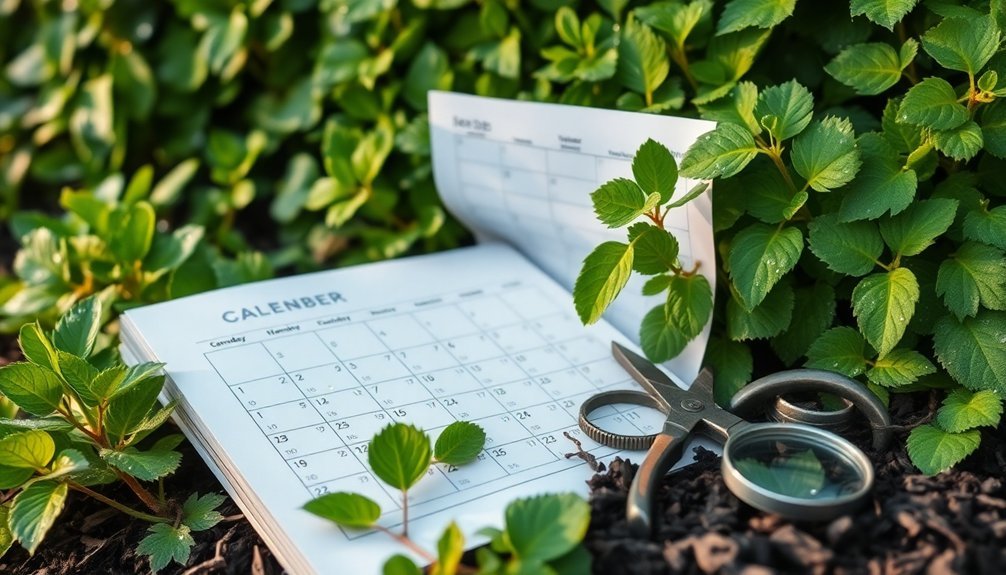The 3 best monthly native hedge care tasks include regular moisture monitoring (check soil weekly with finger test), seasonal pruning at appropriate times (late summer for junipers and keckiella, early winter for Oso Berry), and consistent pest surveillance using a calendar-based approach. You'll need to maintain a 2-inch mulch layer to regulate soil temperature and suppress weeds. These foundational practices guarantee your native hedges develop strong root systems and remain resistant to common problems throughout the growing season.
Seasonal Pruning Rhythm for Native Species

While many gardeners approach hedge maintenance with a one-size-fits-all mentality, native species require a more nuanced pruning rhythm that follows their natural growth cycles.
You'll need to adapt your schedule based on species-specific dormancy periods and growth patterns.
Late summer pruning works well for juniper and keckiella species, focusing on removing dead material and basic shaping. Using sharp pruning tools ensures clean cuts that promote faster healing and reduces risk of disease transmission between plants.
In early winter, when plants like Oso Berry enter dormancy, prune to minimize stress and prepare for spring growth. Cut just above buds to encourage branching.
Spring calls for gentler techniques, waiting until new growth hardens off before trimming.
For ongoing health, establish a regular rhythm of pruning every 2-3 years, always avoiding bird nesting season from March through September.
Monthly Soil and Moisture Management
Because soil conditions directly impact the importance of native hedges, effective monthly management is essential for their long-term health.
Test your soil to understand its composition, then select plants that naturally thrive in these conditions rather than trying to modify what's already there.
Water deeply but infrequently, focusing on root development rather than surface moisture. During establishment, prioritize:
- Maintaining a 2-inch mulch layer that doesn't touch plant crowns
- Using soaker hoses to deliver water directly to roots
- Checking soil moisture weekly with a simple finger test
Native species typically require less watering once established, but monitor during dry periods when rainfall drops below 1 inch.
Mulch serves multiple purposes—moderating soil temperature, preventing crusting, and suppressing weeds—making it your most valuable maintenance tool. Apply a fresh layer of mulch during spring maintenance to conserve moisture throughout the growing season.
Pest and Disease Monitoring Calendar

Since native hedges attract beneficial wildlife while potentially harboring unwanted pests, a systematic monitoring approach becomes necessary for their health. Tracking both pest emergence and plant phenology throughout the seasons provides important timing cues for effective management. Calculating growing degree days from January 1st using a 50°F base temperature provides precise prediction of pest emergence timing.
| Season | Key Monitoring Tasks |
|---|---|
| Early Spring | Check for tent caterpillars and bagworms; use forsythia bloom as indicator for early pest activity |
| Late Spring | Monitor scale insects during egg hatch; watch for plant bugs when Japanese snowbell blooms |
| Summer | Inspect for Japanese beetles, spotted lanternfly; look for Fletcher scale when Goldenraintree blooms |
| Fall | Check for fall webworm; prepare for spring by removing debris; note second-generation scale insects |
Year-round vigilance allows you to implement timely IPM strategies, reducing the need for chemical interventions while maintaining hedge health.
Frequently Asked Questions
How Can I Rejuvenate an Overgrown Native Hedge?
You'll need to prune in stages, focusing on one side at a time. Cut back old growth, fertilize, mulch, and water regularly. Always leave enough foliage for the hedge to recover properly.
Should I Replace or Repair Gaps in My Hedge?
Assess your hedge gaps before deciding. For small gaps, try training nearby branches or adding new plants. For extensive damage, replacing sections may be more effective. Consider the species, growth rate, and your maintenance preferences.
How Do Native Hedges Affect Local Wildlife Populations?
Native hedges provide food, shelter, and travel corridors for wildlife. You'll notice more birds, bees, and butterflies as your hedge creates habitat connections, supports breeding, and offers seasonal resources they've evolved to depend on.
Can I Mix Flowering and Non-Flowering Species in One Hedge?
Yes, you can definitely mix flowering and non-flowering species in one hedge. This combination enhances biodiversity, provides year-round structure, and offers seasonal interest while supporting pollinators and creating diverse wildlife habitats.
What Tools Are Essential for Proper Hedge Maintenance?
You'll need hand pruners for small branches, loppers for thicker stems, hedge trimmers for efficiency, pruning saws for large branches, and don't forget safety gear like gloves, glasses, and ear protection.
In Summary
By following these three essential monthly hedge care routines, you'll guarantee your native species thrive year-round. Remember to prune according to seasonal rhythms, manage soil moisture consistently, and monitor regularly for pests and diseases. These simple yet effective practices don't just maintain your hedgerow—they'll enhance biodiversity, strengthen plant health, and create a resilient natural boundary that'll beautify your property for years to come.





Leave a Reply